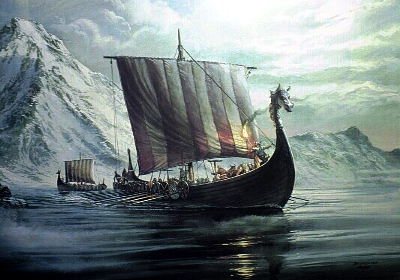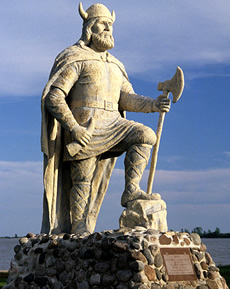World History
Norse immigrants from western Norway discovered and settled Iceland in the late ninth century. Servants and slaves accompanied these families; many of the indentured were Celts from Scotland and Ireland. Much of the history of Norse settlement in Iceland is derived from two Icelandic sagas.
The Book of Icelanders, written by Ari Thorhilsson the Wise in the 10th century, tells of Iceland’s history for the first 250 years after its settlement. The Book of Settlement tells of the founding of Iceland and where they settled.
A Norwegian sailor named Naddodd is said to be the first Viking to discover Iceland. On a seaborne expedition from Norway to the Faeroe Islands in the ninth century, he and his men lost their way and found a new land much farther northwest.
Seeing no sign of human habitation, Naddodd sailed back east, but upon seeing snow fall on the mountains of this new land, decided to name this territory Snowland. Gardar Svarsson, a Swedish Viking, made the next voyage to Iceland.
He circumnavigated the entire island, discovered that it was large and ripe for settlement, and decided to build houses in the northern part of the country in an area now called House Bay, where a village still stands. Gardar renamed Snowland as Gardar’s Island. Flóki Vilgerdarson, another Norwegian Viking, led the next voyage.
He took his family, household, and friends with him and established a second settlement in a fjord in the northwest part of the island. Flóki noticed that a neighboring fjord was full of ice, so he again renamed the island Iceland, the name it has carried ever since.
The Book of Icelanders describes much of the subsequent development of Iceland. Additional settlers arrived in an exodus from Scandinavia, encouraged by the Norse custom of a father’s passing all lands only to his firstborn son.
Because of the general isolation of Icelanders and the lack of native cultures of Iceland, the Norse settlers held on to traditional Viking ways much longer than the Norse in mainland Europe. Icelanders, including Erik the Red, later traveled farther west and settled Greenland.
According to Ari the Wise, the creation of the Althing or General Assembly in 930, which marked the beginning of the Icelandic Commonwealth, created a system of laws in the new country. Iceland was divided into four administrative districts with representatives chosen from each district to create a national legislative body.
Yearly meetings of these representatives at the Althing further refined the laws of the new Icelandic nation. Iceland remained fairly independent from the kingdom of Norway until 1262, when it became a Norwegian Crown colony. From 1387 until 1944 Denmark ruled Iceland following the union of the two kingdoms.
Some of the greatest cultural contributions made by Icelanders were the Icelandic sagas—stories about migration to Iceland, feuds between Icelandic facilities, ancient Germanic and Scandinavian history, and other Norse voyages—and were written in Old Norse.
Most Icelandic sagas were written in the 12th to 14th centuries but discuss events in the period between 930 and 1030, a period referred to as the Age of Sagas. The word saga literally means “what is said,†which is derived from the Norse people’s oral tradition of storytelling.
The texts tend to have an epic quality and are written largely in prose but with poetry embedded within the main text. Sagas often focus on heroic deeds performed by worthy men and women, who were usually Vikings.
The majority of sagas focused on actual events but many detail legends, the mythic powers of saints and holy men, and other fictitious proceedings. All sagas are stylistically linked through their common emphasis on the basic humanity, for good and ill, of the characters in the stories.
For their often-fantastic subject matter, historians have fiercely disputed the accuracy of sagas. For instance the sagas detailing Norse voyages to North America in the year 1000 were only authenticated in the 20th century.
- Leif Ericson
Leif Ericson statue Leif Ericson was an Icelandic explorer who is believed to have been the first European to discover North America and, more specifically, the region that would become known as Newfoundland and then Canada. It is believed that Ericson...
- History Of Iceland
History of Iceland. This essay is a brief history of the European nation of Iceland. Medieval as well as modern history is covered. Wikipedia notes, "Iceland, officially the Republic of Iceland is a country in northern Europe, comprising the island of...
- Project Leif 2000 Greenland
Project Leif 2000 Greenland - Lists events, maps, history, settlements as well as World Heritage Site status for 1,000 year anniversary of the Viking discovery of North America. From the site: In the year 1000 A.D., the legendary Greenlander Leif Eriksson,...
- History Of Denmark
History of Denmark. This is a decent overview to the history of the European nation of Denmark although the emphasis is on modern history. From the site: During the Viking period (9th-11th centuries), Denmark was a great power based on the Jutland Peninsula,...
- Vikings On Greenland
Vikings on Greenland - Presents a brief essay about the history of the Vikings in Greenland, and their explorations further afield, with a map to show their travels. From the site: Around the year 960 the boy Erik and his father got a problem with...
World History
Vikings in Iceland, Icelandic Sagas
 |
| Vikings in Iceland |
Norse immigrants from western Norway discovered and settled Iceland in the late ninth century. Servants and slaves accompanied these families; many of the indentured were Celts from Scotland and Ireland. Much of the history of Norse settlement in Iceland is derived from two Icelandic sagas.
The Book of Icelanders, written by Ari Thorhilsson the Wise in the 10th century, tells of Iceland’s history for the first 250 years after its settlement. The Book of Settlement tells of the founding of Iceland and where they settled.
A Norwegian sailor named Naddodd is said to be the first Viking to discover Iceland. On a seaborne expedition from Norway to the Faeroe Islands in the ninth century, he and his men lost their way and found a new land much farther northwest.
  |   |
Seeing no sign of human habitation, Naddodd sailed back east, but upon seeing snow fall on the mountains of this new land, decided to name this territory Snowland. Gardar Svarsson, a Swedish Viking, made the next voyage to Iceland.
He circumnavigated the entire island, discovered that it was large and ripe for settlement, and decided to build houses in the northern part of the country in an area now called House Bay, where a village still stands. Gardar renamed Snowland as Gardar’s Island. Flóki Vilgerdarson, another Norwegian Viking, led the next voyage.
He took his family, household, and friends with him and established a second settlement in a fjord in the northwest part of the island. Flóki noticed that a neighboring fjord was full of ice, so he again renamed the island Iceland, the name it has carried ever since.
The Book of Icelanders describes much of the subsequent development of Iceland. Additional settlers arrived in an exodus from Scandinavia, encouraged by the Norse custom of a father’s passing all lands only to his firstborn son.
Because of the general isolation of Icelanders and the lack of native cultures of Iceland, the Norse settlers held on to traditional Viking ways much longer than the Norse in mainland Europe. Icelanders, including Erik the Red, later traveled farther west and settled Greenland.
 |
| Viking statue |
Yearly meetings of these representatives at the Althing further refined the laws of the new Icelandic nation. Iceland remained fairly independent from the kingdom of Norway until 1262, when it became a Norwegian Crown colony. From 1387 until 1944 Denmark ruled Iceland following the union of the two kingdoms.
Some of the greatest cultural contributions made by Icelanders were the Icelandic sagas—stories about migration to Iceland, feuds between Icelandic facilities, ancient Germanic and Scandinavian history, and other Norse voyages—and were written in Old Norse.
Most Icelandic sagas were written in the 12th to 14th centuries but discuss events in the period between 930 and 1030, a period referred to as the Age of Sagas. The word saga literally means “what is said,†which is derived from the Norse people’s oral tradition of storytelling.
The texts tend to have an epic quality and are written largely in prose but with poetry embedded within the main text. Sagas often focus on heroic deeds performed by worthy men and women, who were usually Vikings.
The majority of sagas focused on actual events but many detail legends, the mythic powers of saints and holy men, and other fictitious proceedings. All sagas are stylistically linked through their common emphasis on the basic humanity, for good and ill, of the characters in the stories.
For their often-fantastic subject matter, historians have fiercely disputed the accuracy of sagas. For instance the sagas detailing Norse voyages to North America in the year 1000 were only authenticated in the 20th century.
- Leif Ericson
Leif Ericson statue Leif Ericson was an Icelandic explorer who is believed to have been the first European to discover North America and, more specifically, the region that would become known as Newfoundland and then Canada. It is believed that Ericson...
- History Of Iceland
History of Iceland. This essay is a brief history of the European nation of Iceland. Medieval as well as modern history is covered. Wikipedia notes, "Iceland, officially the Republic of Iceland is a country in northern Europe, comprising the island of...
- Project Leif 2000 Greenland
Project Leif 2000 Greenland - Lists events, maps, history, settlements as well as World Heritage Site status for 1,000 year anniversary of the Viking discovery of North America. From the site: In the year 1000 A.D., the legendary Greenlander Leif Eriksson,...
- History Of Denmark
History of Denmark. This is a decent overview to the history of the European nation of Denmark although the emphasis is on modern history. From the site: During the Viking period (9th-11th centuries), Denmark was a great power based on the Jutland Peninsula,...
- Vikings On Greenland
Vikings on Greenland - Presents a brief essay about the history of the Vikings in Greenland, and their explorations further afield, with a map to show their travels. From the site: Around the year 960 the boy Erik and his father got a problem with...
